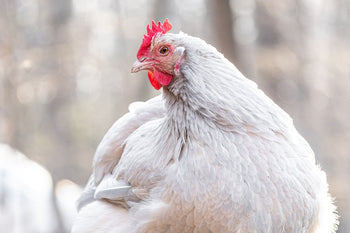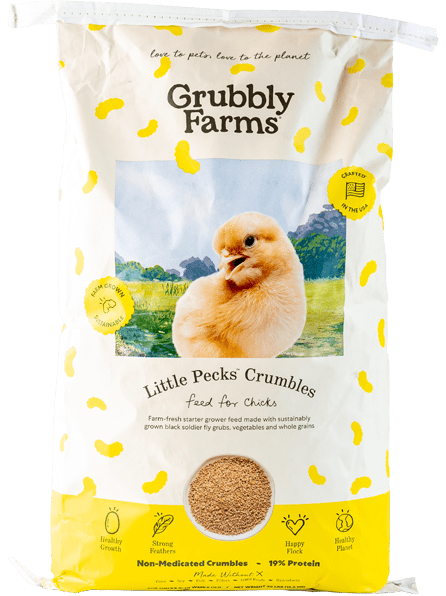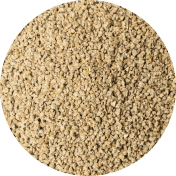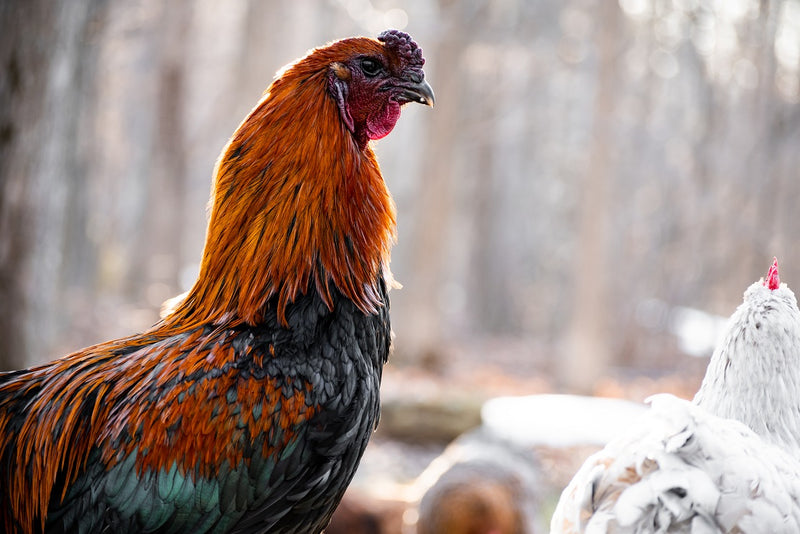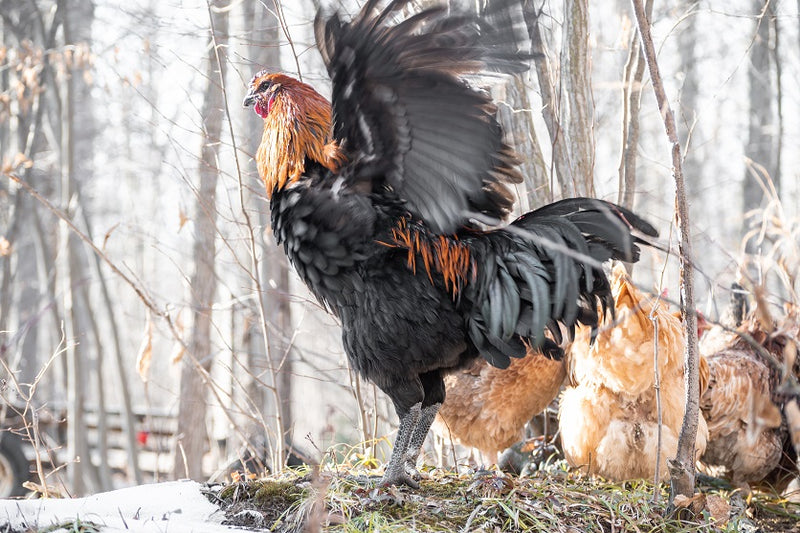Orpington chickens are known as the ‘golden retrievers’ of the chicken world. Their calm, friendly, and even cuddly personalities have earned them this reputation. Plus, they’re a highly versatile breed that adds functionality to any flock. Learn more about this popular chicken breed to see if Orpingtons are a good fit for you.

Unique Features of Orpington Chickens
The Orpington chicken comes from the village of Orpington in Kent County, England. William Cook originally bred them in the late 1800’s. The American Poultry Association accepted the breed in 1902, and the American Bantam Association later recognized the bantam variety of the breed.
Orpington chickens have several distinct features that make them fairly easy to distinguish from other breeds. They have broad, full feathers that lay smooth against their body, though the fluffy down feathers give them a full appearance. Quality Orpingtons will be so well feathered that many of the normal angles of their body shape (neck to back, back to tail) appear rounded or indistinct. Underneath all those feathers, Orpingtons should have a broad back and a full breast.
Orpingtons have medium-sized combs and bright red wattles. Both sexes should have single combs that stand upright and have five points. Nevertheless, the combs and wattles on cocks will get larger than those on hens. Orpingtons have short legs, four toes on each foot, and are clean-legged.
A standard-size Orpington hen should weigh eight pounds and a standard cock should tip the scales at ten pounds. The bantam version of the Orpington breed is mostly raised as pets or for show, with hens weighing 34 ounces and cocks 38 ounces.
There are several varieties of Orpingtons, which can make for a fun and colorful flock. However, the American Poultry Association does not recognize them all–only buff, black, blue, and white. Unrecognized Orpington varieties include lavender, splash, diamond jubilee, red, and spangled.
The buff Orpington remains the most popular and easiest to source, though their high demand has caused them to become overbred and lack quality. Hatchery buff Orpingtons rarely meet the standards set for the breed. While they are still friendly and have good layers of feathers, they often lack the size and fluffiness of standard-bred Orpingtons.

Purpose: Meat or Egg Production?
Orpingtons are considered a heritage, dual-purpose chicken breed. This means they were developed for both egg and meat production. Standard Orpingtons make a great dual-purpose breed because of their large size and quick maturation. Their broad breasts and full body are characteristics of a good meat bird.
Today, Orpingtons are mostly raised for egg production. However, those raised for meat can be butchered when they are around 22 weeks of age for a good source of quality, white-skinned meat.
Egg Production
Orpington hens will lay between 200 to 250 eggs annually. Those bred specifically for egg production will lay on the higher end, while Orpingtons bred for their standard will lay fewer eggs.
Typically, Orpington hens lay large eggs that are light brown in color. As with many chicken breeds, different strains of Orpingtons may lay different tinted eggs. In fact, some Orpingtons are known to lay light brown eggs with a slight pinkish hue.
They are great winter-time layers, as the hens are not as affected by cold weather and will continue laying during the winter months. They still require 12 to 16 hours of light each day to support laying. However, young pullets will often lay straight through the winter even without supplemental light.
Temperature Tolerance
Orpingtons are a very cold hardy chicken breed. Their large size and numerous feathers make them well-adapted to cold weather. Additionally, the hens have small combs and wattles, which makes them less prone to frostbite. As with any chicken breed, you should still winterize the chicken coop and take the appropriate measures to prevent cold stress in your flock.
These chickens are not as heat tolerant given their size and dense feathering. They don’t adapt as readily to warm climates and can be prone to heat stress during the summer. Orpingtons need access to plenty of shade and fresh, cool water during hot weather. They are not a good breed choice if you live in a region that experiences warm weather year-round or hot summers.
Orpington chickens do best in a clean, dry environment. Their thick feather layers don’t dry very fast. If the bird gets wet, they can get chilly and dirty quickly, so make sure your Orpingtons have a clean, dry coop and a sheltered run to get outside even during inclement weather.
Common Health Issues
The Orpington chicken is a fairly hardy breed that’s not genetically predisposed to many poultry ailments or diseases. To keep your flock healthy, practice good biosecurity such as minimizing exposure to wild birds, quarantining sick or new chickens, and not sharing chicken-keeping equipment with other poultry raisers.
Keep the chicken coop and run clean and well-ventilated to prevent disease-causing pathogens from proliferating. A balanced and varied diet can also help your birds develop a strong immune system to stay healthy. Orpingtons should always have access to a complete layer feed and the hens should receive supplemental calcium. Supply snacks, treats, and natural supplements in moderation.
Here are a few healthcare concerns when raising Orpingtons (or any large, fluffy chicken breed):
Parasites- External parasites can be an issue in heavily feathered chicken breeds. Mites and lice can easily hide in the dense feathers, making an infestation harder to recognize. Do a monthly health check on your birds and ensure they have access to a dust bath to help prevent external parasites.
Bumblefoot- Bumblefoot is a staph infection of the foot pad common to heavy chicken breeds. Jumping down from high perches puts a lot of pressure on the foot pad and can result in cracks or abrasions that allow a staph infection to enter the foot. Keep perches and nests no further than one to two feet off the ground to help prevent bumblefoot.
Frostbite- Orpington cocks are prone to frostbite on their large combs and wattles during the winter. Prevent frostbite with a well-ventilated coop that has low moisture and wind exposure. You can also apply a beeswax salve to the rooster’s comb and wattles to prevent moisture from freezing on the skin.
Obesity- Since Orpingtons are a large breed, it’s difficult to tell when they’re getting obese. Obesity can trigger a decline in egg production and other reproductive issues or organ failure. To prevent obesity, give Orpingtons plenty of room to stretch their legs, encourage active foraging, and offer treats and snacks in moderation. You can also space the feeder and water apart to encourage your birds to move around and stay active.

Lifespan of Orpingtons
Like many heritage chicken breeds, well-bred Orpingtons have a longer natural lifespan compared to hybrid breeds. The average lifespan of an Orpington chicken is over ten years, with some living well into their 20s when given good care and a proper diet.
Orpington hens are most productive when they are two to three years old. However, some hens will produce until five years of age or older.
Breeding plays a big role in both lifespan and productivity. Orpingtons bred for egg production will often lay extremely well for the first couple of years but have a shorter lifespan. Standard-bred Orpingtons won’t lay as prolifically, but they will often lay well into old age and have a longer lifespan.
Providing Orpingtons with a proper diet, minimizing stress factors, and preventing disease can help your chickens live to a ripe old age!
Temperament
Orpingtons are one of the friendliest and most docile chicken breeds. Standard-bred Orpingtons are calm, gentle, and not flighty due to their large size. Even the roosters tend to have an easygoing demeanor.
Keep in mind that each chicken will have its own personality, and some Orpingtons will be more active than others. Good breeding plays a big part in having approachable, affectionate Orpingtons. Buff Orpingtons have a reputation as the friendliest variety, making them a great family-friendly chicken breed since they are calm and gentle towards kids.
Orpingtons are also quiet and get along well with other chicken breeds. Since they don’t tend to be assertive, they can often be lower in the pecking order when kept in a mixed flock with more active chicken breeds.
Suitability for Backyard Flocks
Orpingtons are a great chicken breed to add to a backyard flock! Because of their unique build, they do well in regions that experience cold winters and mild summers. They adapt well to both confinement and free-range, although they don’t tend to be strong foragers due to their large size.
If kept in confinement, Orpingtons need plenty of space to stay active and healthy. Make sure your backyard chicken coop is big enough to accommodate a large chicken breed. Allow at least four to five square feet of coop space and 10 to 12 square feet of covered run space per Orpington. If you have restricted space for your backyard flock, you may consider a different, smaller chicken breed. Or, consider getting bantam Orpingtons if you just want a pet!
Orpingtons are also known to go broody. These hens will happily sit on a clutch of eggs and raise chicks if given the chance. When hens go broody they stop laying, which may be undesirable if you are raising your flock for egg production. However, broody hens become an excellent asset when you have fertile eggs that you want to hatch. If you have a broody Orpington but no fertile eggs to give her, you will need to break her of her broodiness so that she starts laying again.
Conclusion
Orpingtons make a great backyard chicken breed because they are dual-purpose, cold-hardy, and have affectionate personalities! Their laid-back demeanor makes them a popular chicken breed for beginners and anyone looking to raise a family-friendly flock.





